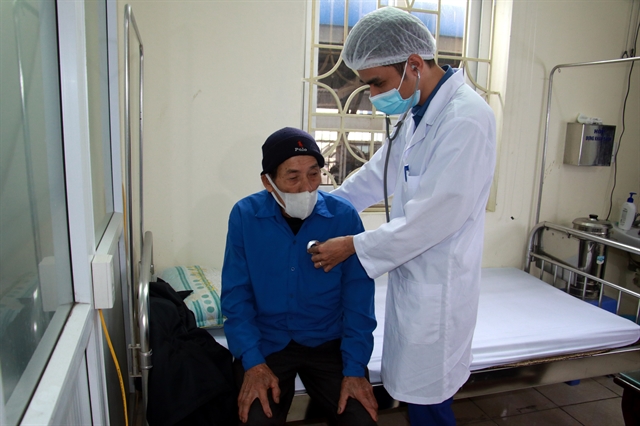 Society
Society


|
| Doctor diagnosing a tuberculosis patient in Nam Định. — VNA/VNS Photo Nguyễn Lành |
HÀ NỘI — Despite efforts from the National Tuberculosis Control Program, tuberculosis is mutating and developing a resistance to antibiotics and drugs, making it difficult to handle this dangerous disease effectively.
Việt Nam is one of the 30 countries currently troubled by tuberculosis and its drug-resistant mutations.
While tuberculosis can be prevented and treated, according to the World Health Organization (WHO), an estimated 10.6 million people around the world are still infected each year, resulting in 1.5 million deaths, equivalent to more than 4,100 deaths per day, and nearly 30,000 new cases.
WHO's report also shows that Việt Nam is currently ranked 11th among 30 countries with the highest burden of tuberculosis and multidrug-resistant tuberculosis.
Each year, there are about 169,000 new tuberculosis cases in Việt Nam, of which 4,000 are multidrug-resistant tuberculosis cases.
This disease also causes about 14,200 deaths each year.
The daunting recent data shows that drug-resistant mutations are prevailing, with about 8,900 new cases of rifampicin-resistant and multidrug-resistant tuberculosis reported annually in Việt Nam.
According to Đinh Văn Lượng, Director of the National Tuberculosis Control Program at the Central Lung Hospital, multidrug-resistant tuberculosis is very serious.
This happens when the bacteria causing tuberculosis undergoes a mutation that makes it resistant to drugs used in treatment, leading to patients not seeing any improvement in their symptoms or worsening symptoms.
Multidrug-resistant tuberculosis bacteria is also very transmissive, posing a significant threat to public health.
According to Lượng, though considered a 'silent killer', ordinary tuberculosis can be completely cured by following protocol and treatment time, with a cure rate of over 90 per cent.
Treating tuberculosis becomes a much more daunting task when dealing with drug-resistant strains though. In addition to strict adherence to treatment with many medications, the treatment time is also longer, and the cure rate is only about 65-70 per cent.
For people suffering from extremely drug-resistant tuberculosis, the road to recovery is tough. Patients must take highly toxic drugs for up to 20 months, with many adverse side effects and long-term harm, which dissuaded many from continuing the treatment.
If patients are not detected and treated early, they can suffer organ damage, resulting in poorer recovery and more complications.
Patients also become a dangerous source of infection for their families and communities, causing many unpredictable consequences. According to estimates, drug-resistant tuberculosis causes hundreds of deaths in Việt Nam every year.
Due to the long and difficult treatment time and the need for more types of drugs, the cost of treating drug-resistant tuberculosis is tens of times higher than treating regular tuberculosis patients.
According to Nguyễn Kim Cương, Head of the Respiratory Tuberculosis Department at the Central Lung Hospital, most tuberculosis patients are affected by the "'disastrous cost' of treatment.
When diagnosed with tuberculosis, patients will face many difficulties, such as job limitations, communication barriers, and loss of working time to earn a living, which affects the patient's overall quality of life.
One estimate puts the cost of treatment for most patients at around 20 per cent of their annual income.
About 70 per cent of tuberculosis patients are of working age, and 20,000 patients are not covered by health insurance. Furthermore, about 70 per cent of patients are classified as being from poor and near-poor households.
On average, a person with tuberculosis must miss three to four months of work.
Since July 2022, tuberculosis drugs have been provided to patients by the Social Health Insurance Fund to solve the above problem.
This is an important milestone in ensuring financial support for tuberculosis treatment programs in Việt Nam, helping to reduce the financial burden on patients and demonstrating the humanity of the policy.
Patients can now use their Social Health Insurance card to visit other clinics and use tuberculosis drugs while their entitlements are still guaranteed.
Although tuberculosis drugs are provided free of charge, due to the prolonged treatment time and many associated illnesses, the cost of treatment for a patient can amount to hundreds of millions in VNĐ.
Therefore, tuberculosis is a problem that greatly affects the economy of each family in particular and the country as a whole.
Lượng, who is also the head of the National Tuberculosis Control Program, believes that to improve the effectiveness of tuberculosis prevention and control, especially drug-resistant tuberculosis, patients must adhere to the following: early detection, effective treatment for sensitive cases, enhanced screening, and early detection of tuberculosis cases, especially drug-resistant tuberculosis.
Lượng also noted that to prevent the spread of the disease to those around them, patients with drug-resistant pulmonary tuberculosis must comply with treatment according to instructions to achieve the highest effectiveness.
Patients must wear masks when interacting with others to prevent the spread of tuberculosis into the community.
People who come into contact with pulmonary tuberculosis patients in general, especially drug-resistant tuberculosis, need to undergo screening to detect tuberculosis actively, receive early treatment to improve treatment effectiveness, and cut off the transmission of tuberculosis and drug-resistant tuberculosis in the community. — VNS




